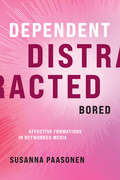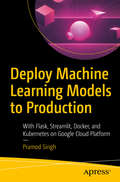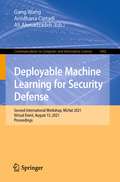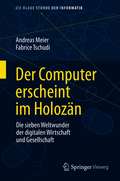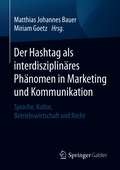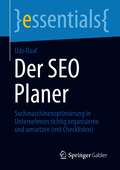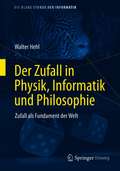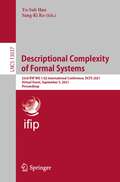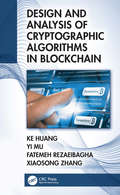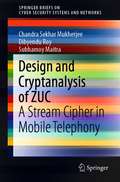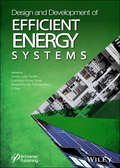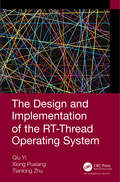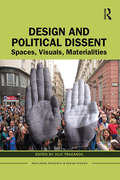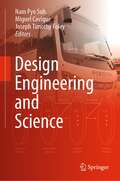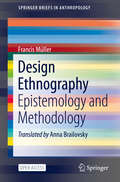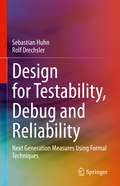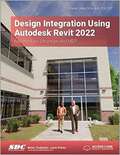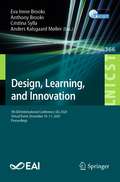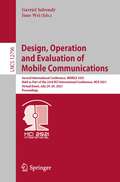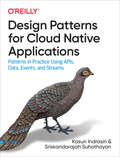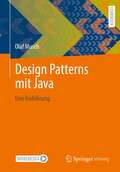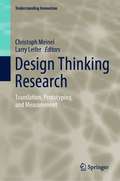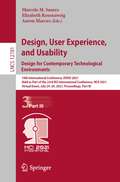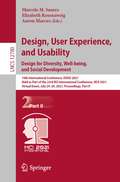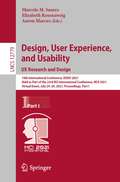- Table View
- List View
Dependent, Distracted, Bored: Affective Formations in Networked Media
by Susanna PaasonenA new approach to understanding the culture of ubiquitous connectivity, arguing that our dependence on networked infrastructure does not equal addiction.In this book, Susanna Paasonen takes on a dominant narrative repeated in journalistic and academic accounts for more than a decade: that we are addicted to devices, apps, and sites designed to distract us, that drive us to boredom, with detrimental effect on our capacities to focus, relate, remember, and be. Paasonen argues instead that network connectivity is a matter of infrastructure and necessary for the operations of the everyday. Dependencies on it do not equal addiction but speak to the networks within which our agency can take shape.
Deploy Machine Learning Models to Production: With Flask, Streamlit, Docker, and Kubernetes on Google Cloud Platform
by Pramod SinghBuild and deploy machine learning and deep learning models in production with end-to-end examples.This book begins with a focus on the machine learning model deployment process and its related challenges. Next, it covers the process of building and deploying machine learning models using different web frameworks such as Flask and Streamlit. A chapter on Docker follows and covers how to package and containerize machine learning models. The book also illustrates how to build and train machine learning and deep learning models at scale using Kubernetes.The book is a good starting point for people who want to move to the next level of machine learning by taking pre-built models and deploying them into production. It also offers guidance to those who want to move beyond Jupyter notebooks to training models at scale on cloud environments. All the code presented in the book is available in the form of Python scripts for you to try the examples and extend them in interesting ways.What You Will LearnBuild, train, and deploy machine learning models at scale using KubernetesContainerize any kind of machine learning model and run it on any platform using DockerDeploy machine learning and deep learning models using Flask and Streamlit frameworksWho This Book Is ForData engineers, data scientists, analysts, and machine learning and deep learning engineers
Deployable Machine Learning for Security Defense: Second International Workshop, MLHat 2021, Virtual Event, August 15, 2021, Proceedings (Communications in Computer and Information Science #1482)
by Gang Wang Arridhana Ciptadi Ali AhmadzadehThis book constitutes selected and extended papers from the Second International Workshop on Deployable Machine Learning for Security Defense, MLHat 2021, held in August 2021. Due to the COVID-19 pandemic the conference was held online. The 6 full papers were thoroughly reviewed and selected from 7 qualified submissions. The papers are organized in topical sections on machine learning for security, and malware attack and defense.
Der Computer erscheint im Holozän: Die sieben Weltwunder der digitalen Wirtschaft und Gesellschaft (Die blaue Stunde der Informatik)
by Andreas Meier Fabrice TschudiDie sieben Weltwunder wurden bereits in der Antike beschrieben, etwa zur selben Zeit wie die mechanische Rechenhilfe Abacus, ein Zählrahmen mit Holz- oder Glasperlen. Dieses Buch beschreibt und diskutiert die sieben Weltwunder der IT, ohne die unsere digitale Wirtschaft und Gesellschaft kaum überlebensfähig scheint: Computermaus, Datenbanken, Kryptografie, Graphgrammatiken, Internet, Blockchain und Soft Computing. Jedes Weltwunder der IT wird kurz charakterisiert, bevor Anwendungsoptionen für Wirtschaft und Gesellschaft exemplarisch aufgezeigt und gewürdigt werden. Das Werk richtet sich an alle, die sich mit der digitalen Transformation auseinandersetzen. Es soll helfen, digitale Entwicklungen im eigenen Unternehmen, in der Verwaltung oder im öffentlichen wie im privaten Leben zu positionieren und zu reflektieren.
Der Hashtag als interdisziplinäres Phänomen in Marketing und Kommunikation: Sprache, Kultur, Betriebswirtschaft und Recht
by Matthias Johannes Bauer Miriam GoetzDas Hashtagging, also der Prozess, Hashtags zu setzen, ist ein noch recht neuartiger Prozess der digitalen Verschlagwortung. Die Funktion des Hashtags geht dabei weit über den ursprünglichen Zweck der Verschlagwortung hinaus: Grundsätzlich ist der Hashtag zunächst tragendes Element gegenwärtiger politischer Debatten- und Diskussionskultur. Darüber hinaus hat er eine prominente Rolle im heutigen Marketing eingenommen: Zu nennen sind die bereits existierenden Hashtags einerseits, die die Marketer als Trittbrettfahrer nutzen. Andererseits wird angestrebt, möglichst einzigartige und profilgebende Begriffe und Neuschöpfungen im Hashtag-Marketing zu finden. Im Kampagnenmanagement müssen heute nicht nur juristische Aspekte, sondern auch Shitstorms und Hashtag-Hijacking als Risikofaktoren in Betracht gezogen werden. Bei der sprachlichen Kreation von Hashtags kommen spezifische Regeln zum Tragen, die teils linguistischen Normen folgen, teils aber auch bewusst gegen diese verstoßen oder sogar verstoßen müssen. Hashtags können sich auf ein extrem breit gefächertes Thema beziehen, allgemeingültig oder austauschbar sein. Dann liefert die Suche nach Hashtags kaum zielführende Ergebnisse. Dem stehen Hashtags gegenüber, die so dezidiert und speziell sind, dass sie für einen Großteil der Nutzer des jeweiligen sozialen Mediums irrelevant sind. Die Buchbeiträge zeigen die Größe des Spannungsfelds des Phänomens Hashtag sowie den aktuellen Forschungsstand aus unterschiedlichen disziplinären Blickwinkeln. Sie behandeln Problemstellungen, eröffnen weiterführende Forschungsansätze und nennen Beispiele aus der Unternehmenspraxis.
Der SEO Planer: Suchmaschinenoptimierung in Unternehmen richtig organisieren und umsetzen (mit Checklisten) (essentials)
by Udo RaafDieses Buch ermöglicht einen leichten Einstieg in die Entwicklung einer funktionierenden SEO-Strategie und soll Unternehmen helfen, Suchmaschinenoptimierung fehlerfrei zu planen. Der Autor setzt kein technisches Wissen voraus und fokussiert auf die Kernthemen, die SEO gelingen lassen.Suchmaschinenoptimierung bedeutet nicht nur „Google Optimierung“, sondern öffnet auch einen direkten Kanal zum Kunden. Wenn wir uns mit SEO beschäftigen, werden auch diese wichtigen Fragen beantwortet: Was wird eigentlich von unseren Kunden gesucht? Wie wird gesucht? Wer sind denn überhaupt unsere Kunden und wer ist der Wettbewerb? Und vor allem: wie kann ich Menschen erreichen, die das Unternehmen bisher noch gar nicht kennen?Während Social Media schwerpunktmäßig nur „Fans“ eines Unternehmens oder Organisation erreicht, kann SEO nachhaltig neue Kunden anlocken - ohne sie mit Werbung zu belästigen. Anhand der Analyse von Suchanfragen kann SEO den konkreten Bedarf der eigenen Kunden sichtbar machen. Kein Unternehmen sollte diese zentrale Aufgabe im Online Marketing komplett an Agenturen auslagern, sondern sich selbst mit Suchmaschinenoptimierung befassen und das vorhandene Wissen im Haus kontinuierlich auf- und ausbauen. Im Essential zeigt Udo Raaf, wie man als Unternehmen ins Thema einsteigt und welche Werkzeuge dabei helfen, den eigenen Content zu verbessern. Er führt dazu in 8 Schritten durch den gesamten Prozess der Suchmaschinenoptimierung und benennt alle Faktoren, die für Menschen und Suchmaschinen relevant sind, um Web-Inhalte sichtbarer zu machen. Mit einem Vorwort von Prof. Dr. Mario Fischer (Herausgeber der Fachzeitschrift „Website Boosting“).
Der Zufall in Physik, Informatik und Philosophie: Zufall als Fundament der Welt (Die blaue Stunde der Informatik)
by Walter HehlDer Zufall ist uns unheimlich. Wir dachten, es gäbe ihn nicht, hinter allem stehe Gott oder eine vernünftige Erklärung. Aber wir wissen heute: Es gibt ihn. Wir wissen, dass vieles dessen, was uns umgibt und das wir nicht durchschauen, trotzdem kausal abläuft. Anders als zu Zeiten der Aufklärung gedacht, ist der Zufall um uns eher die Regel als die gesetzmäßige Ordnung. Die Wolken sind Fraktale, die Wellen auf dem Meer sind eine reine Zufallsmaschinerie. Der Philosoph Charles Peirce hat genau in diesem Sinn noch vor Quanten- und Chaostheorie die fundamentale Bedeutung des Zufalls erkannt und der Lehre ihren Namen gegeben: Tychismus.Ohne Zufall gäbe es nichts Neues, kein Leben, keine Kreativität, keine Geschichte.Dieses Buch betrachtet den Zufall aus Sicht der Physik, der Informatik und der Philosophie. Es spannt den Bogen von der Antike zur Quantenphysik und zeigt, dass der Zufall fest in die Welt eingebaut ist und es sie ohne Zufall nicht gäbe.
Descriptional Complexity of Formal Systems: 23rd IFIP WG 1.02 International Conference, DCFS 2021, Virtual Event, September 5, 2021, Proceedings (Lecture Notes in Computer Science #13037)
by Yo-Sub Han Sang-Ki KoThis book constitutes the proceedings of the 23rd International Conference on Descriptional Complexity of Format Systems, DCFS 2021, which was supposed to take place in Seoul South Korea in June 2021, but the conference was canceled due to the COVID-19 crisis.The 16 full papers presented in this volume were carefully reviewed and selected from 21 submissions. The conference focus to all aspects of descriptional complexity-the costs of description of objects in various computational models such as Turing machines, pushdown automata, finite automata or grammars.
Design and Analysis of Cryptographic Algorithms in Blockchain
by Yi Mu Xiaosong Zhang Ke Huang Fatemeh RezaeibaghaThis book seeks to generalize techniques and experiences in designing and analyzing cryptographic schemes for blockchain. It devotes three chapters to review the background and basic knowledge, four chapters to discuss specific types of cryptographic primitive design for blockchain, one chapter to discuss optimization tools and another chapter for blockchain regulation and economies. This book covers the systematic survey of research objects, as well as detailed reviews of cryptographic schemes, lectures and methodologies to practice cryptography. The main findings of this book are summarized as following, first, the practical design and analysis of cryptographic schemes for blockchain can address major problems in blockchain at algorithmic level. Then, some intrinsic deficiencies in some traditional cryptographic primitives, like centralized setup, impractical design, etc, prevent the successful application of these primitives in blockchain. However, huge efforts are being made to make these primitives practical and applicable for researchers. Finally, the formal and rigorous design and analysis of public key cryptographic algorithms is vital to blockchain. Design and Analysis of Cryptographic Algorithms in Blockchain is a useful textbook for graduate students and PhD students, or researches who wish to connect cryptography with blockchain for research and developing projects.
Design and Cryptanalysis of ZUC: A Stream Cipher in Mobile Telephony (SpringerBriefs on Cyber Security Systems and Networks)
by Chandra Sekhar Mukherjee Dibyendu Roy Subhamoy MaitraThis book is a timely document of state-of-the art analytical techniques in the domain of stream cipher design and analysis with a specific cipher, named ZUC. It links new research to brief contextual literature review in the domain of complex LFSR-based stream ciphers. A snapshot of how stream ciphers are deployed in the mobile telephony architecture, one of the most well-known topics for more than five decades in the domain of computer and communication sciences, is presented in this book. The book provides an in-depth study on design and cryptanalysis of ZUC as well as relevant research results in this field with directions towards future analysis of this cipher.
Design and Development of Efficient Energy Systems (Artificial Intelligence and Soft Computing for Industrial Transformation)
by Suman Lata Tripathi Sanjeevikumar Padmanaban Dushyant Kumar Singh P. RajaThere is not a single industry which will not be transformed by machine learning and Internet of Things (IoT). IoT and machine learning have altogether changed the technological scenario by letting the user monitor and control things based on the prediction made by machine learning algorithms. There has been substantial progress in the usage of platforms, technologies and applications that are based on these technologies. These breakthrough technologies affect not just the software perspective of the industry, but they cut across areas like smart cities, smart healthcare, smart retail, smart monitoring, control, and others. Because of these “game changers,” governments, along with top companies around the world, are investing heavily in its research and development. Keeping pace with the latest trends, endless research, and new developments is paramount to innovate systems that are not only user-friendly but also speak to the growing needs and demands of society. This volume is focused on saving energy at different levels of design and automation including the concept of machine learning automation and prediction modeling. It also deals with the design and analysis for IoT-enabled systems including energy saving aspects at different level of operation. The editors and contributors also cover the fundamental concepts of IoT and machine learning, including the latest research, technological developments, and practical applications. Valuable as a learning tool for beginners in this area as well as a daily reference for engineers and scientists working in the area of IoT and machine technology, this is a must-have for any library.
The Design and Implementation of the RT-Thread Operating System
by Qiu Yi Xiong Puxiang Tianlong ZhuSince the release of V0.01 in 2006, to the present V4.0 version, RT-Thread has developed a reputation among developers for its open source strategy. RT-Thread has gained a large following among members of the embedded open source community in China with hundreds of thousands of enthusiasts. RT-Thread is widely used in energy, automotive, medical, consumer electronics, among other applications, making it a mature and stable open source embedded operating system. The purpose of RT-Thread RTOS Design and Implementation is to create an easy learning curve for mastering RT-Thread, so that more developers can participate in the development of RT-Thread and work together to create an open source, tiny, and beautiful Internet of Things operating system. The book’s first part introduces the RT-Thread kernel and starts with an overview of RT-Thread before covering thread management, clock management, inter-thread synchronization, inter-thread communication, memory management, and interrupt management. The second part begins with RT-Thread kernel porting and explains how to port RT-Thread to a hardware board to run it. The second part also introduces RT-Thread components and discusses the Env development environment, FinSH console, device management, and network framework. Additional topics covered include: The I/O device framework Virtual file systems Peripheral interfaces Devices including the PIN device, UART device, and ADC device, among others. Each chapter features code samples, as well as helpful tables and graphs, so you can practice as you learn as well as perform your own experiments.
Design and Political Dissent: Spaces, Visuals, Materialities (Routledge Research in Design Studies)
by Jilly TraganouThis book examines, through an interdisciplinary lens, the relationship between political dissent and processes of designing. In the past twenty years, theorists of social movements have noted a diversity of visual and performative manifestations taking place in protest, while the fields of design, broadly defined, have been characterized by a growing interest in activism. The book’s premise stems from the recognition that material engagement and artifacts have the capacity to articulate political arguments or establish positions of disagreement. Its contributors look at a wide array of material practices generated by both professional and nonprofessional design actors around the globe, exploring case studies that vary from street protests and encampments to design pedagogy and community-empowerment projects. For students and scholars of design studies, urbanism, visual culture, politics, and social movements, this book opens up new perspectives on design and its place in contemporary politics.
Design Engineering and Science
by Nam Pyo Suh Miguel Cavique Joseph Timothy FoleyDesign Engineering and Science teaches the theory and practice of axiomatic design (AD). It explains the basics of how to conceive and deliver solutions to a variety of design problems. The text shows how a logical framework and scientific basis for design can generate creative solutions in many fields, including engineering, materials, organizations, and a variety of large systems.Learning to apply the systematic methods advocated by AD, a student can construct designs that lead to better environmental sustainability and to increased quality of life for the end-user at the same time reducing the overall cost of the product development process. Examples of previous innovations that take advantage of AD methods include:• on-line electric vehicle design for electric buses with wireless power supply;• mobile harbors that allow unloading of large ships in shallow waters;• microcellular plastics with enhanced toughness and lower weight; and• organizational changes in companies and universities resulting in more efficient and competitive ways of working.The book is divided into two parts. Part I provides detailed and thorough instruction in the fundamentals of design, discussing why design is so important. It explains the relationship between and the selection of functional requirements, design parameters and process variables, and the representation of design outputs. Part II presents multiple applications of AD, including examples from manufacturing, healthcare, and materials processing.Following a course based on this text students learn to create new products and design bespoke manufacturing systems. They will gain insight into how to create imaginative design solutions that satisfy customer needs and learn to avoid introducing undue complexity into their designs. This informative text provides practical and academic insight for engineering design students and will help instructors teach the subject in a novel and more rigorous fashion. Their knowledge of AD will stand former students in good stead in the workplace as these methods are both taught and used in many leading industrial concerns.
Design Ethnography: Epistemology and Methodology (SpringerBriefs in Anthropology)
by Francis MüllerThis open access book describes methods for research on and research through design. It posits that ethnography is an appropriate method for design research because it constantly orients itself, like design projects, towards social realities. In research processes, designers acquire project-specific knowledge, which happens mostly intuitively in practice. When this knowledge becomes the subject of reflection and explication, it strengthens the discipline of design and makes it more open to interdisciplinary dialogue. Through the use of the ethnographic method in design, this book shows how design researchers can question the certainties of the everyday world, deconstruct reality into singular aesthetic and semantic phenomena, and reconfigure them into new contexts of signification. It shows that design ethnography is a process in which the epistemic and creative elements flow into one another in iterative loops. The goal of design ethnography is not to colonize the discipline of design with a positivist and objectivist scientific ethos, but rather to reinforce and reflect upon the explorative and searching methods that are inherent to it. This innovative book is of interest to design researchers and professionals, including graphic artists, ethnographers, visual anthropologists and others involved with creative arts/media.
Design for Testability, Debug and Reliability: Next Generation Measures Using Formal Techniques
by Sebastian Huhn Rolf DrechslerThis book introduces several novel approaches to pave the way for the next generation of integrated circuits, which can be successfully and reliably integrated, even in safety-critical applications. The authors describe new measures to address the rising challenges in the field of design for testability, debug, and reliability, as strictly required for state-of-the-art circuit designs. In particular, this book combines formal techniques, such as the Satisfiability (SAT) problem and the Bounded Model Checking (BMC), to address the arising challenges concerning the increase in test data volume, as well as test application time and the required reliability. All methods are discussed in detail and evaluated extensively, while considering industry-relevant benchmark candidates. All measures have been integrated into a common framework, which implements standardized software/hardware interfaces.
Design Integration Using Autodesk Revit 2022
by Daniel John StineDesign Integration Using Autodesk Revit 2022 is designed to provide you with a well-rounded knowledge of Autodesk Revit tools and techniques. <p><p>All three disciplines of the Revit platform are introduced in this textbook. This approach gives you a broad overview of the Building Information Modeling (BIM) process. The topics cover the design integration of most of the building disciplines: Architectural, Interior Design, Structural, Mechanical, Plumbing and Electrical. Civil is not covered, but adding topography to your model is. Each book also includes access to nearly 100 video tutorials designed to further help you master Autodesk Revit. <p><p> Throughout the book you develop a two story law office. The drawings start with the floor plans and develop all the way to photo-realistic renderings similar to the one on the cover of this book. Along the way the building’s structure, ductwork, plumbing and electrical (power and lighting) are modeled. By the end, you will have a thorough knowledge of many of the Revit basics needed to be productive in a classroom or office environment. Even if you will only be working with one component of Revit in your chosen profession, this book will give you important knowledge on how the other disciplines will be doing their work and valuable insight into the overall process. <p><p> The first four chapters cover many of the Revit basics needed to successfully and efficiently work with the software. Once the fundamentals are covered, the remaining chapters walk you through a building project which is started from scratch so nothing is taken for granted by you or the author.
Design, Learning, and Innovation: 5th EAI International Conference, DLI 2020, Virtual Event, December 10-11, 2020, Proceedings (Lecture Notes of the Institute for Computer Sciences, Social Informatics and Telecommunications Engineering #366)
by Eva Irene Brooks Anthony Brooks Cristina Sylla Anders Kalsgaard MøllerThis book constitutes the refereed post-conference proceedings the 5th EAI International Conference on DLI 2020, Design, Leaning and Innovation, which took place in December 2020. Due to COVID-19 pandemic the conference was held virtually. The 14 revised full papers presented were carefully selected from 40 submissions and are organized in four thematic sessions on: digital technologies and learning; designing for innovation; digital games, gamification and robots; designs for innovative learning.
Design, Operation and Evaluation of Mobile Communications: Second International Conference, MOBILE 2021, Held as Part of the 23rd HCI International Conference, HCII 2021, Virtual Event, July 24–29, 2021, Proceedings (Lecture Notes in Computer Science #12796)
by Gavriel Salvendy June WeiThis conference proceeding LNCS 12796 constitutes the thoroughly refereed proceedings of the 1th International Conference on Cross-Cultural Design, CCD 2019, which was held as part of the 23rd HCI International Conference, HCII 2021 as a virtual event, due to COVID-19, in July 2021.The total of 1276 papers and 241 posters included in the 39 HCII 2021 proceedings volumes were carefully reviewed and selected from 5222 submissions. MOBILE 2021 includes a total of 27 papers; they were organized in topical sections named: Designing, Developing and Evaluating Mobile Interaction Systems and User Experience, Acceptance and Impact of Mobile Communications.
Design Patterns for Cloud Native Applications
by Kasun Indrasiri Sriskandarajah SuhothayanWith the immense cost savings and scalability the cloud provides, the rationale for building cloud native applications is no longer in question. The real issue is how. With this practical guide, developers will learn about the most commonly used design patterns for building cloud native applications using APIs, data, events, and streams in both greenfield and brownfield development.You'll learn how to incrementally design, develop, and deploy large and effective cloud native applications that you can manage and maintain at scale with minimal cost, time, and effort. Authors Kasun Indrasiri and Sriskandarajah Suhothayan highlight use cases that effectively demonstrate the challenges you might encounter at each step.Learn the fundamentals of cloud native applicationsExplore key cloud native communication, connectivity, and composition patternsLearn decentralized data management techniquesUse event-driven architecture to build distributed and scalable cloud native applicationsExplore the most commonly used patterns for API management and consumptionExamine some of the tools and technologies you'll need for building cloud native systems
Design Patterns mit Java: Eine Einführung
by Olaf MuschEine praxisnahe Beschreibung der Software Design Patterns, wie sie im 1994 erschienen Buch „Design Patterns – Elements of Reusable Object-Oriented Software“ der Autorengruppe Gamma, Helm, Johnson und Vlissides (auch genannt „Gang of Four“, kurz GoF, also „Viererbande“) Erwähnung finden.Alle Muster werden anhand von Beispielen detailliert erläutert und auch kritisch gewürdigt. Darüber hinaus werden Entwurfsprinzipien der objektorientierten Programmierung beschrieben und berücksichtigt. Alle Beispiele sind ausführlich im Quellcode kommentiert und unter Java 16 lauffähig. Teilweise werden auch neuere Features von Java bis einschließlich Version 16 erläutert und verwendet.
Design Thinking Research: Translation, Prototyping, and Measurement (Understanding Innovation)
by Christoph Meinel Larry LeiferExtensive research conducted by the Hasso Plattner Design Thinking Research Program at Stanford University in Palo Alto, California, USA, and the Hasso Plattner Institute in Potsdam, Germany, has yielded valuable insights on why and how design thinking works. The participating researchers have identified metrics, developed models, and conducted studies, which are featured in this book, and in the previous volumes of this series. This volume provides readers with tools to bridge the gap between research and practice in design thinking with varied real world examples. Several different approaches to design thinking are presented in this volume. Acquired frameworks are leveraged to understand design thinking team dynamics. The contributing authors lead the reader through new approaches and application fields and show that design thinking can tap the potential of digital technologies in a human-centered way. In a final section, new ideas in neurodesign at Stanford University and at Hasso Plattner Institute in Potsdam are elaborated upon thereby challenging the reader to consider newly developed methodologies and provide discussion of how these insights can be applied to various sectors. Special emphasis is placed on understanding the mechanisms underlying design thinking at the individual and team levels. Design thinking can be learned. It has a methodology that can be observed across multiple settings and accordingly, the reader can adopt new frameworks to modify and update existing practice. The research outcomes compiled in this book are intended to inform and provide inspiration for all those seeking to drive innovation – be they experienced design thinkers or newcomers.
Design, User Experience, and Usability: 10th International Conference, DUXU 2021, Held as Part of the 23rd HCI International Conference, HCII 2021, Virtual Event, July 24–29, 2021, Proceedings, Part III (Lecture Notes in Computer Science #12781)
by Marcelo M. Soares Elizabeth Rosenzweig Aaron MarcusThis three volume set LNCS 12779, 12780, and 12781 constitutes the refereed proceedings of the 10th International Conference on Design, User Experience, and Usability, DUXU 2021, held as part of the 23rd International Conference, HCI International 2021, which took place in July 2021. Due to COVID-19 pandemic the conference was held virtually. The total of 1276 papers and 241 poster papers included in the 39 HCII 2021 proceedings volumes was carefully reviewed and selected from 5222 submissions. The regular papers of DUXU 2021 are organized in topical sections named: Mobile UX Research and Design; DUXU for Extended Reality; DUXU for the Creative Industries; Usability and UX Studies.
Design, User Experience, and Usability: 10th International Conference, DUXU 2021, Held as Part of the 23rd HCI International Conference, HCII 2021, Virtual Event, July 24–29, 2021, Proceedings, Part II (Lecture Notes in Computer Science #12780)
by Marcelo M. Soares Elizabeth Rosenzweig Aaron MarcusThis three volume set LNCS 12779, 12780, and 12781 constitutes the refereed proceedings of the 10th International Conference on Design, User Experience, and Usability, DUXU 2021, held as part of the 23rd International Conference, HCI International 2021, which took place in July 2021. Due to COVID-19 pandemic the conference was held virtually. The total of 1276 papers and 241 poster papers included in the 39 HCII 2021 proceedings volumes was carefully reviewed and selected from 5222 submissions. The regular papers of DUXU 2021 are organized in topical sections named: Experience Design across Cultures; Design for Inclusion and Social Development¸ Design for Health and Well-being; DUXU Case Studies.
Design, User Experience, and Usability: 10th International Conference, DUXU 2021, Held as Part of the 23rd HCI International Conference, HCII 2021, Virtual Event, July 24–29, 2021, Proceedings, Part I (Lecture Notes in Computer Science #12779)
by Marcelo M. Soares Elizabeth Rosenzweig Aaron MarcusThis three volume set LNCS 12779, 12780, and 12781 constitutes the refereed proceedings of the 10th International Conference on Design, User Experience, and Usability, DUXU 2021, held as part of the 23rd International Conference, HCI International 2021, which took place in July 2021. Due to COVID-19 pandemic the conference was held virtually.The total of 1276 papers and 241 poster papers included in the 39 HCII 2021 proceedings volumes was carefully reviewed and selected from 5222 submissions. The regular papers of DUXU 2021 are organized in topical sections named: UX Design Methods and Techniques; Methods and Techniques for UX Research; Visual Languages and Information Visualization; Design Education and Practice.
